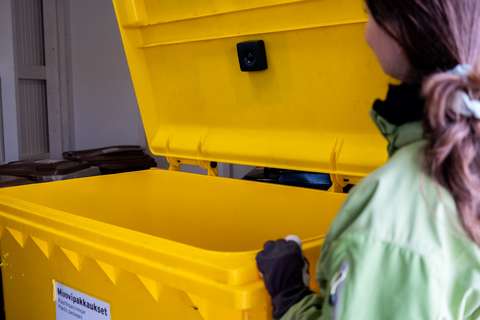Sensors measure school waste volumes

We want to improve waste sorting and recycling opportunities at schools through informed decision-making. We are measuring waste amounts at three pilot schools from October to February.
Espoo raises circular economy natives
Espoo promotes the increase of sorting opportunities at schools with determination. In accordance with the Sustainable Espoo programme that guides the city, we want the children and young people of Espoo to grow into circular economy natives. Schoolchildren who sort waste and are aware of the importance of sorting take us towards a sustainable future in tangible ways.
However, effective measures need information to support them. At the moment, the city does not have precise information about what kind of waste is generated at schools and, consequently, what kind of waste should be collected from schools and how often. Helsinki Region Environmental Services HSY collects information on the quantities and emptying intervals of bins, but there is usually no information on how full the bin was when it was emptied. Some of the bins may be empty while others may be filled up too quickly, causing people to put reusable waste into the adjacent mixed waste bin, which still has room. In both cases, the system could be optimised if we only knew what was needed.
Sensors show actual waste volume
There are now sensors on the lids of mixed waste and plastic recycling bins at the recycling stations of three pilot schools, which measure the filling rate of the bins in real time, like a sonar. The pilot is part of the Closed Plastic Circle – from Pilots into Practice project, which aims to promote the circulation of plastics and the growth of the recycled plastic market. The sensors were acquired as a service from Wastebook(external link, opens in a new window).
The data generated by the sensors allows us to optimise bin numbers and emptying intervals, as well as the measures needed to increase sorting. With the help of the data, we can also anticipate the need for recycling bins at schools that do not have them yet. The appropriate number of bins and their timely emptying saves emissions from waste transport and the property’s waste management costs.
Three schools of different sizes located in different parts of Espoo with communities already somewhat accustomed to sorting different waste fractions were selected for the pilot: Aarnivalkean koulu primary school, Ruusutorpan koulu comprehensive school and Karhusuon koulu comprehensive school. During the measurement period, events are also organised at the pilot schools to inspire waste sorting, including circular economy lessons and joint analysis of measurement data. Schoolchildren have access to waste data from both their own school and the other pilot schools – it is also interesting to see what kind of changes in sorting habits result from the sorting campaign and reflection.
Circular economy is achieved through cooperation
Only when people sort their waste properly can the waste management company deliver it to a treatment plant where it is processed raw material for new products. Only then can a product made of recycled plastic be offered in the store alongside a product made of virgin material. To succeed, the circular economy needs us all, and each of us has a role to play in the circular economy.
The ‘Closed Plastic Circle – from Pilots to Practice’ project is conducting several smaller pilots similar to the measurement pilot with the aim of gaining new insights and finding further development opportunities. In addition to the pilots, we are also carrying out more extensive concept development and material research. Read more about the project on the project website.